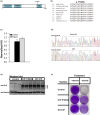A mutation in Site-1 Protease is associated with a complex phenotype that includes episodic hyperCKemia and focal myoedema
- PMID: 31070020
- PMCID: PMC6625134
- DOI: 10.1002/mgg3.733
A mutation in Site-1 Protease is associated with a complex phenotype that includes episodic hyperCKemia and focal myoedema
Abstract
Background: Site-1 Protease (S1P) is a Golgi-resident protein required for the activation of regulatory proteins that drive key cellular functions, including, the unfolded protein response (UPR) and lipid and cholesterol biosynthesis. While disruptions in S1P function have been widely characterized in animal models, to date, the implications of disrupted S1P function in human disease states are not completely known.
Methods: The patient and both parents underwent whole exome and mitochondrial DNA sequencing, and Sanger sequencing was used to confirm the mutation. Western blotting and immunofluorescence studies were performed on either proband-derived fibroblasts or on an established cell line to assess protein expression and cellular localization of the mutated S1P protein. Quantitative real-time PCR and luciferase reporter assays were used to examine activation of S1P target pathways in the context of the S1P mutation.
Results: We describe a female patient with a de novo heterozygous missense mutation in the transmembrane domain of S1P (p. Pro1003Ser). The patient presented to our neuromuscular clinic with episodic, activity-induced, focal myoedema and myalgias with hyperCKemia. Her clinical phenotype was complex and included gastrointestinal hypomotility, ocular migraines, and polycystic ovary syndrome. Molecular analysis using proband-derived fibroblasts and cell lines harboring the Pro1003Ser mutation demonstrated increased activation of UPR and lipid and cholesterol regulatory pathways and localization of S1P Pro1003Ser in the Golgi.
Conclusion: These findings suggest a critical function for S1P in several human organ systems and implicate an important role for S1P in various human disease states.
Keywords: ER stress; MBTPS1; PCOS; SREBP; Site-1 Protease; hyperCKemia; myoedema.
© 2019 The Authors. Molecular Genetics & Genomic Medicine published by Wiley Periodicals, Inc.
Conflict of interest statement
Rita Brookheart and Brian Finck hold a provisional patent related to this work (provisional patent application #62/638,531).
Figures


Similar articles
-
Site-1 protease deficiency causes human skeletal dysplasia due to defective inter-organelle protein trafficking.JCI Insight. 2018 Jul 26;3(14):e121596. doi: 10.1172/jci.insight.121596. eCollection 2018 Jul 26. JCI Insight. 2018. PMID: 30046013 Free PMC article.
-
SPRING licenses S1P-mediated cleavage of SREBP2 by displacing an inhibitory pro-domain.Nat Commun. 2024 Jul 9;15(1):5732. doi: 10.1038/s41467-024-50068-8. Nat Commun. 2024. PMID: 38977690 Free PMC article.
-
Cartilage-specific ablation of site-1 protease in mice results in the endoplasmic reticulum entrapment of type IIb procollagen and down-regulation of cholesterol and lipid homeostasis.PLoS One. 2014 Aug 22;9(8):e105674. doi: 10.1371/journal.pone.0105674. eCollection 2014. PLoS One. 2014. PMID: 25147951 Free PMC article.
-
Site-1 protease and lysosomal homeostasis.Biochim Biophys Acta Mol Cell Res. 2017 Nov;1864(11 Pt B):2162-2168. doi: 10.1016/j.bbamcr.2017.06.023. Epub 2017 Jul 8. Biochim Biophys Acta Mol Cell Res. 2017. PMID: 28693924 Review.
-
Site-1 and site-2 proteases: A team of two in regulated proteolysis.Biochim Biophys Acta Mol Cell Res. 2022 Jan;1869(1):119138. doi: 10.1016/j.bbamcr.2021.119138. Epub 2021 Oct 5. Biochim Biophys Acta Mol Cell Res. 2022. PMID: 34619164 Review.
Cited by
-
Exome Sequencing Reveals Biallelic Mutations in MBTPS1 Gene in a Girl with a Very Rare Skeletal Dysplasia.Diagnostics (Basel). 2024 Jan 31;14(3):313. doi: 10.3390/diagnostics14030313. Diagnostics (Basel). 2024. PMID: 38337829 Free PMC article.
-
Case Report: Recombinant human growth hormone therapy in a patient with spondyloepiphyseal dysplasia, Kondo-Fu type.Front Pediatr. 2023 Feb 3;11:1068718. doi: 10.3389/fped.2023.1068718. eCollection 2023. Front Pediatr. 2023. PMID: 36816387 Free PMC article.
-
Clinical and molecular characterization of a patient with MBTPS1 related spondyloepiphyseal dysplasia: Evidence of pathogenicity for a synonymous variant.Front Pediatr. 2023 Jan 11;10:1056141. doi: 10.3389/fped.2022.1056141. eCollection 2022. Front Pediatr. 2023. PMID: 36714646 Free PMC article.
-
S1P defects cause a new entity of cataract, alopecia, oral mucosal disorder, and psoriasis-like syndrome.EMBO Mol Med. 2022 May 9;14(5):e14904. doi: 10.15252/emmm.202114904. Epub 2022 Apr 1. EMBO Mol Med. 2022. PMID: 35362222 Free PMC article.
-
Identification of a New Variant of the MBTPS1 Gene of the Kondo-Fu Type of Spondyloepiphyseal Dysplasia (SEDKF) in a Saudi Patient.Case Rep Pediatr. 2022 Oct 25;2022:5498109. doi: 10.1155/2022/5498109. eCollection 2022. Case Rep Pediatr. 2022. PMID: 36330313 Free PMC article.
References
-
- Brandl, K. , Rutschmann, S. , Li, X. , Du, X. , Xiao, N. , Schnabl, B. , … Beutler, B. (2009). Enhanced sensitivity to DSS colitis caused by a hypomorphic Mbtps1 mutation disrupting the ATF6‐driven unfolded protein response. Proceedings of the National Academy of Sciences, 106(9), 3300–3305. 10.1073/pnas.0813036106 - DOI - PMC - PubMed
-
- Brown, M. S. , Faust, J. R. , Goldstein, J. L. , Kaneko, I. , & Endo, A. (1978). Induction of 3‐hydroxy‐3‐methylglutaryl coenzyme A reductase activity in human fibroblasts incubated with compactin (ML‐236B), a competitive inhibitor of the reductase. The Journal of Biological Chemistry, 253(4), 1121–1128. - PubMed
Publication types
MeSH terms
Substances
Grants and funding
LinkOut - more resources
Full Text Sources

